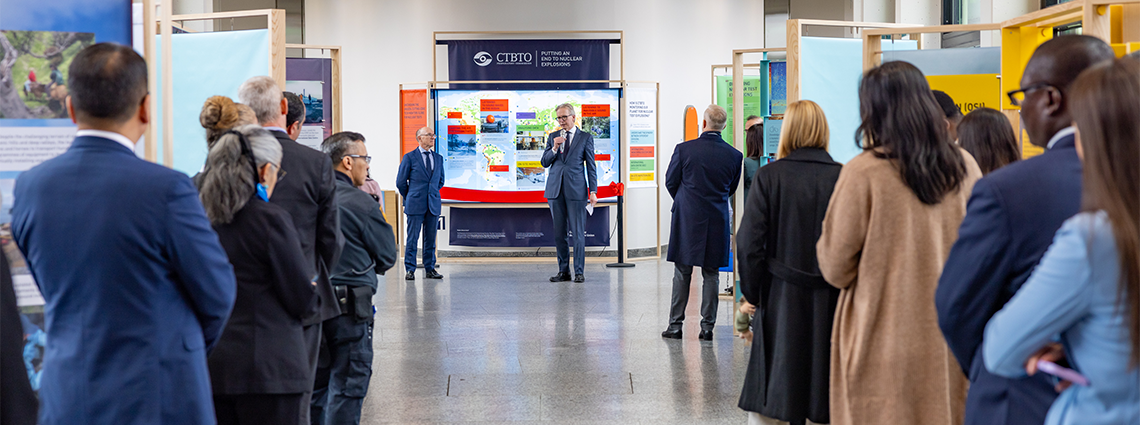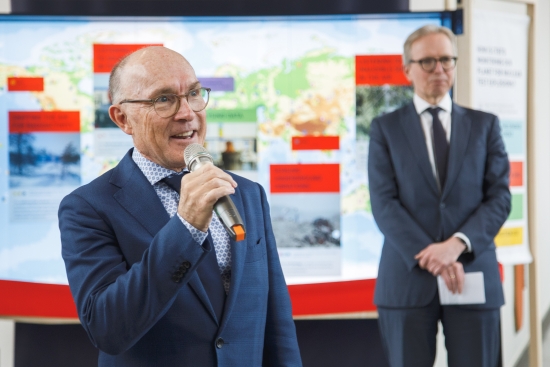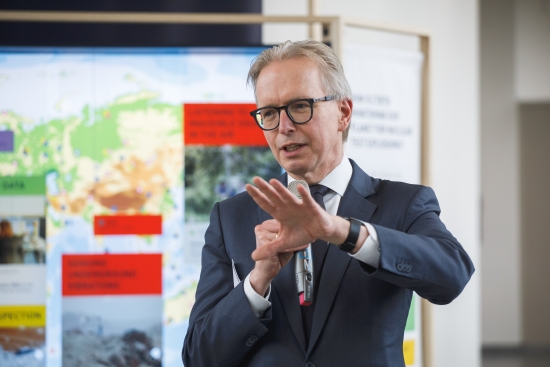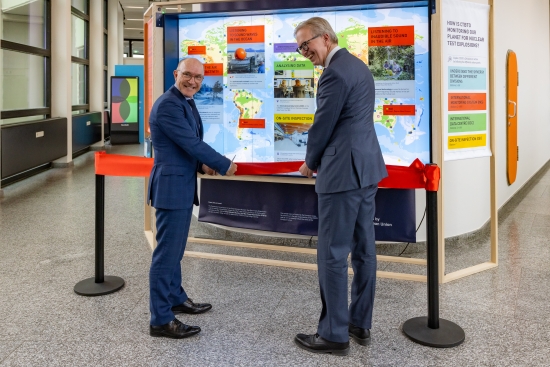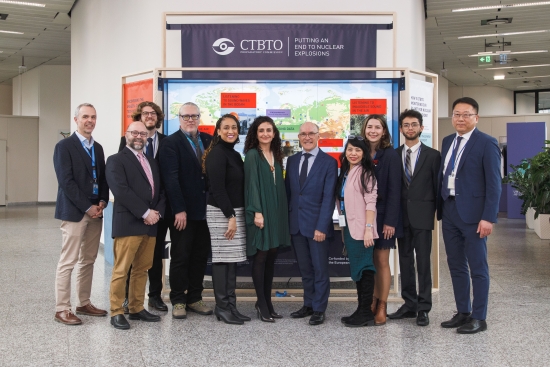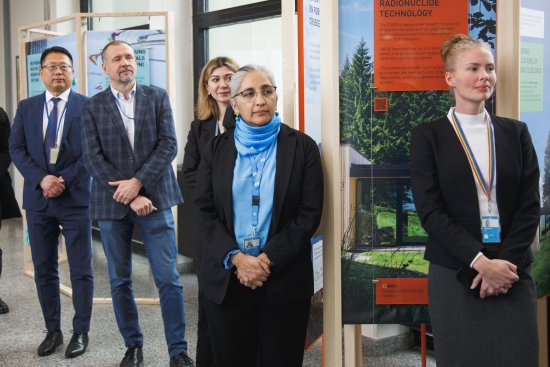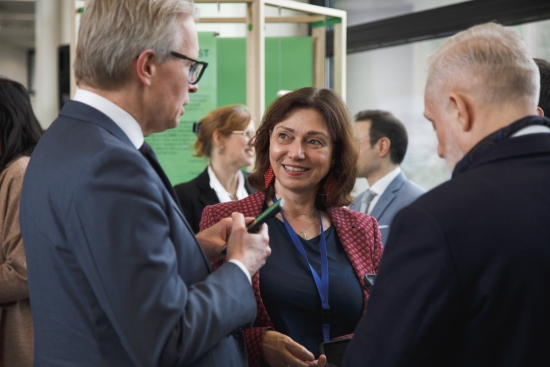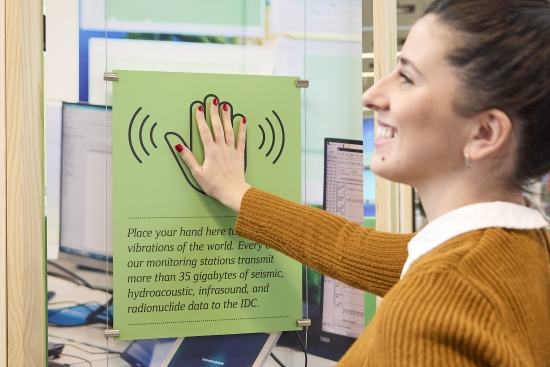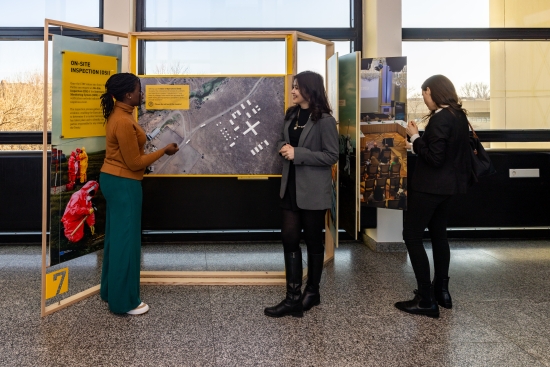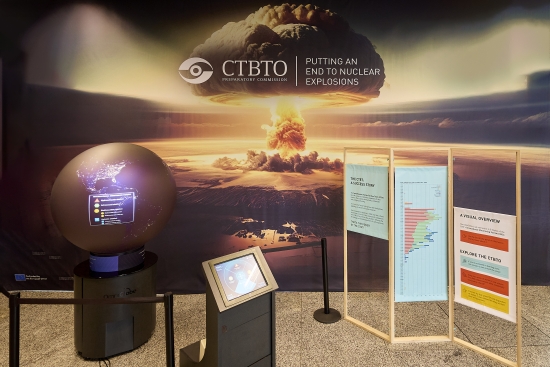CTBTO unveils new permanent exhibit at Vienna International Centre
The Comprehensive Nuclear-Test-Ban Treaty Organization (CTBTO) has officially launched a new permanent exhibit at the Vienna International Centre (VIC), the central hub for approximately 20 UN organizations in Austria.
The opening, held on 22 February, was attended by Executive Secretary Robert Floyd, the chairs of the Organization’s Preparatory Commission and Working Groups A and B, staff from the CTBTO, and representatives from the European Union delegation in Vienna, including Ambassador Carl Hallergård of the European Union.
A glimpse into CTBTO’s mission
During the event, attendees had the opportunity to explore the various installations showcasing CTBTO's mission to end nuclear testing.
The Executive Secretary stressed the importance of the exhibit in engaging visitors in the work of the CTBTO.
"Our new exhibit invites visitors to interactively explore how the CTBTO supports international peace and security. It highlights the successes of our unique comprehensive verification system, which can detect any nuclear explosion anywhere, and shows some of the civil and scientific uses of our data. I am so pleased that this will enable more people to learn about our Treaty and its contribution to nuclear non-proliferation and disarmament."
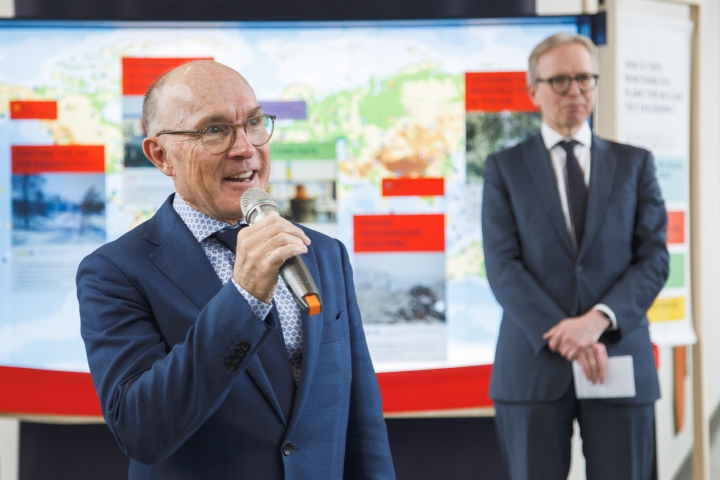
Executive Secretary Robert Floyd speaking during opening ceremony of new CTBTO exhibit at Vienna International Centre
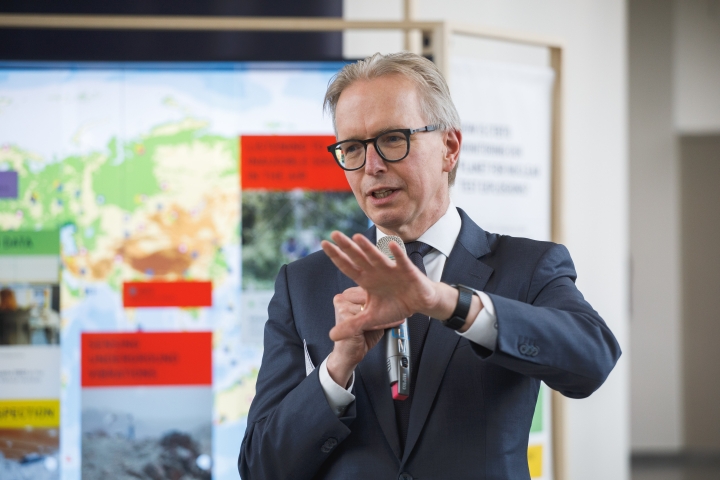
Ambassador Hallergård delivering remarks
EU-backed project
The two-year project, co-funded by the European Union, received praise from Ambassador Hallergård.
The EU’s extra- budgetary support to the CTBTO, dating back to 2006, has been demonstrated through the adoption of various Joint Actions and EU Council Decisions. These are a direct result of the EU's 2003 Strategy against the Proliferation of Weapons of Mass Destruction, which is the foundation of the EU's commitment to promote the entry-into-force of the CTBT. The aim is to enhance the capabilities of the Comprehensive Nuclear-Test-Ban Treaty (CTBT) monitoring system, empower States Signatories to fulfil their verification duties, and maximise the benefits of CTBT membership. These efforts also serve to raise awareness of the Treaty and advocate for its universal adoption and entry into force.
Regular assessed contributions from EU Member States make up approximately 40 percent of the Organization's total budget. In addition, the European Union is a leading contributor of voluntary funding to the CTBTO.
"We are delighted to support this important exhibition. The EU actively supports the CTBT, both politically and financially. Through this exhibition we further consolidate the EU-CTBTO partnership, based on the principles of multilateralism, international cooperation, peace, and security. It complements a range of EU-funded programmes and activities in support of the CTBTO verification regime, capacity building and outreach."
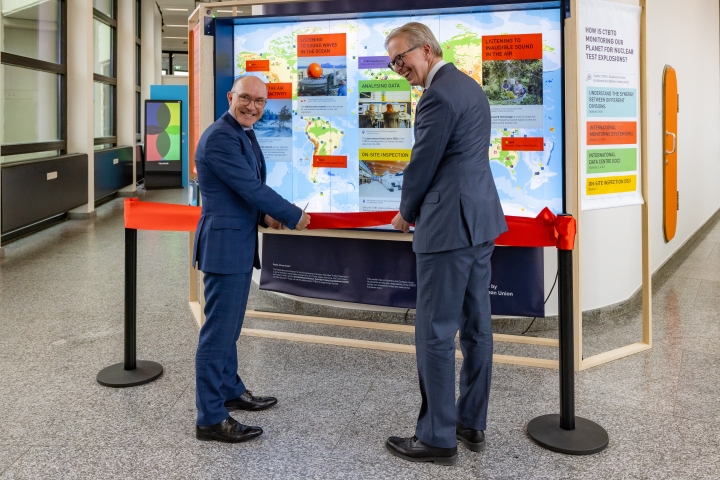
Floyd and Ambassador Hallergård cutting ribbon at opening event
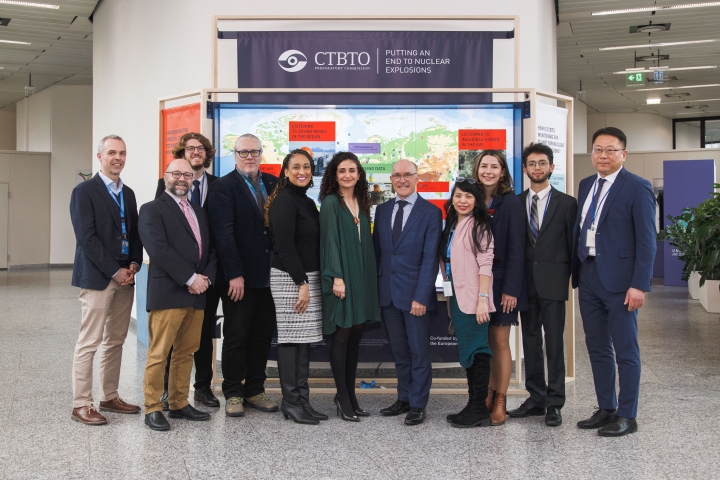
Floyd with Public Information team, which spearheaded exhibit redesign project
Inside the exhibit: an overview of the stations
The new exhibit features nine stations highlighting the workings of the International Monitoring System (IMS), the International Data Centre (IDC), and On-Site Inspection (OSI).
The goal of the exhibit is to share the CTBTO story with the more than 50,000 visitors who take guided tours at the Vienna International Centre each year and showcase the collaborative efforts among the three technical divisions in detecting nuclear tests. The immersive and interactive exhibit allows visitors to feel the earth’s vibrations, listen to the sounds of the ocean, generate seismic waves, and imagine building an On-Site Inspection Base of Operations (BoO) to fully grasp the process of detecting nuclear test explosions.
Station 1 features an interactive map with movable glass panels, displaying the CTBTO's verification system, while also providing examples of the four technologies used to monitor the planet for nuclear tests. Additionally, a colour-coded index serves as a guide for tour groups, indicating the purpose of each station and how it fits into the bigger picture.
Station 2 focuses on seismic technology, one of the four methods used to detect nuclear test explosions. Here, visitors are invited to do a jump test, allowing them to observe the movement of seismic waves on a screen.
Shaped like a diamond, Station 3 centres on the IDC, where analysts keep a watchful eye on the planet round the clock to detect nuclear tests. Visitors can feel the “vibrations of the world” by touching a hand icon, representing the daily transmission of over 35 gigabytes of seismic, hydroacoustic, infrasound, and radionuclide data to the IDC Operations Centre in Vienna.
Station 4 explores hydroacoustic technology and provides insights into the installation of station HA04 in the Crozet Islands —one of the most challenging within the IMS network.
At Station 5, the focus is on the various civil and scientific applications of CTBTO's data, showcasing its versatility in tracing radiation, tracking climate change, studying marine life, and monitoring earthquakes, tsunamis, and volcanic eruptions. This station includes an interactive component where visitors can participate in an activity to match three spectrograms with their corresponding sounds, such as a tsunami-generating earthquake, the sound of an iceberg grounding, and a whale song. Visitors can flip the cards to reveal the correct answers and use a QR code to listen to the three sounds.
Station 6, the second diamond-shaped station, dedicates one side to explaining how infrasound technology functions within CTBTO's verification system. This stand also provides insights into the installation of infrasound station IS14 on Robinson Crusoe Island in the Southern Pacific Ocean, which has been operational since 2004.
On the other side of the panel, visitors can learn about the role of radionuclide technology in confirming whether an explosion detected by the other three technologies was indeed a nuclear test. This section features radionuclide station RN33 in Schauinsland, Freiburg, Germany, detailing a facility upgrade - a key element in IMS’ ongoing efforts to maintain and sustain the state-of-the-art network.
Station 7 centres on an On-Site Inspection (OSI), the final component of CTBTO's verification regime. The various phases of an OSI are presented as pages in a flipbook. Additionally, this station features a fictional miniature model of a Base of Operations, representing where OSI activities take place in the field. Visitors are encouraged to consider how they would organise the models of work tents and equipment containers.
Station 8 provides information on how visitors can contribute to CTBTO’s mission through three panels: "Working for the Organization", "Joining the CTBTO Youth Group (CYG)", and "Becoming a member of the Young Professionals Network (YPN)." Each panel has its own QR code, directing visitors to dedicated web pages for more information.
Station 9 features the OmniGlobe, an interactive data visualisation tool showcasing the CTBTO’s verification system. Large icons on a screen can be pressed to view the IMS network.
Beyond these immersive installations, CTBTO’s new exhibit underscores the collective efforts in shaping a safer world. Additionally, an EU-funded 22-page brochure titled "The EU's Special Effort: Promoting Peace, Security, and the Comprehensive Nuclear-Test-Ban Treaty" serves as an informative resource, offering further insights into the path towards a nuclear-test-free world.
22 Feb 2024

CTBTO staff listening to speakers

CTBTO staff taking part in guessing game at civil and scientific applications station

Ambassador Hallergård during opening event
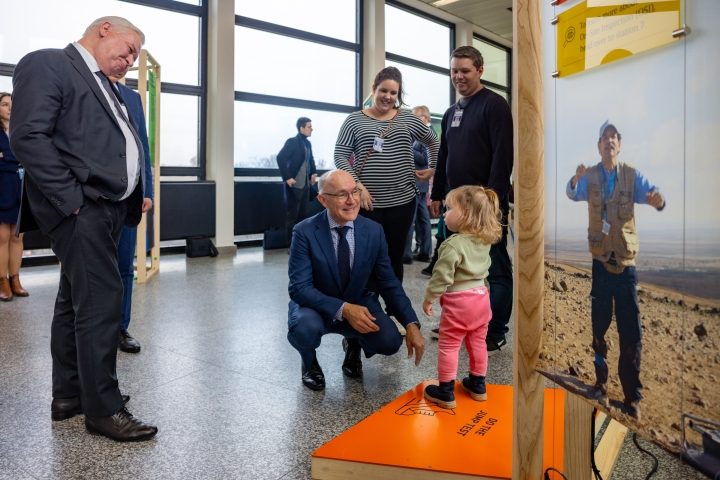
Child doing jump test during opening event
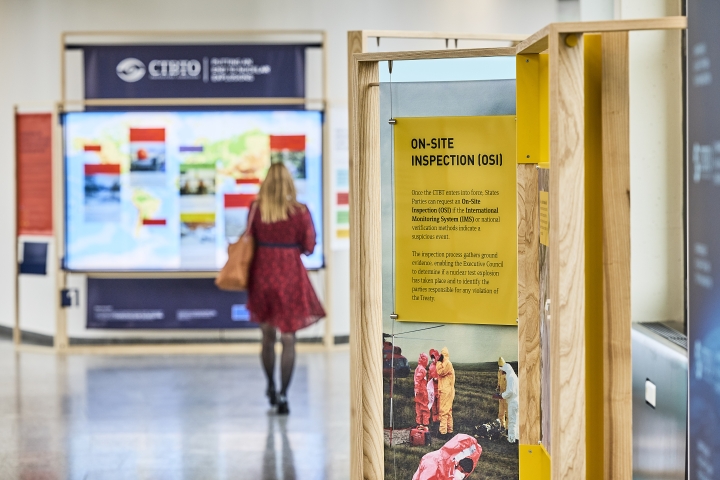
Overview of CTBTO's new exhibit at VIC
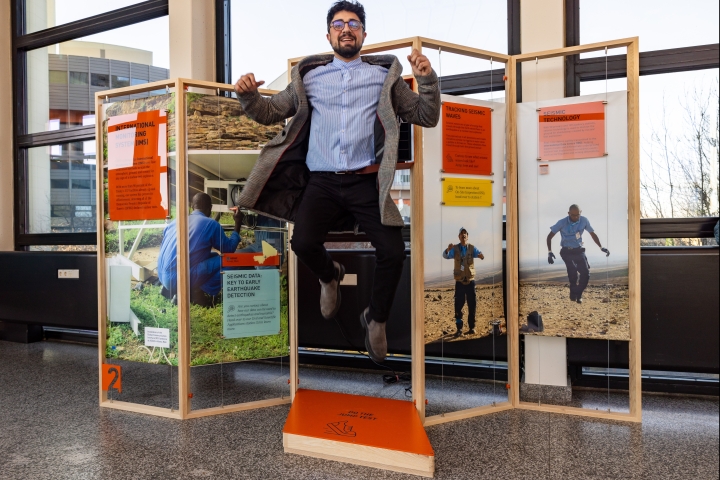
Visitor doing jump test at station showcasing use of seismic technology in CTBTO’s verification system
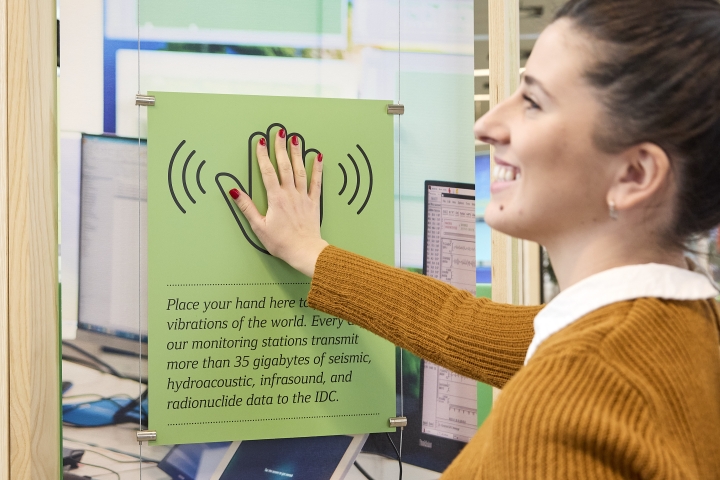
Visitor interacting with International Data Centre (IDC) stand at exhibit

Visitors at On-Site Inspection (OSI) station at exhibit

Visitors interacting with exhibit station
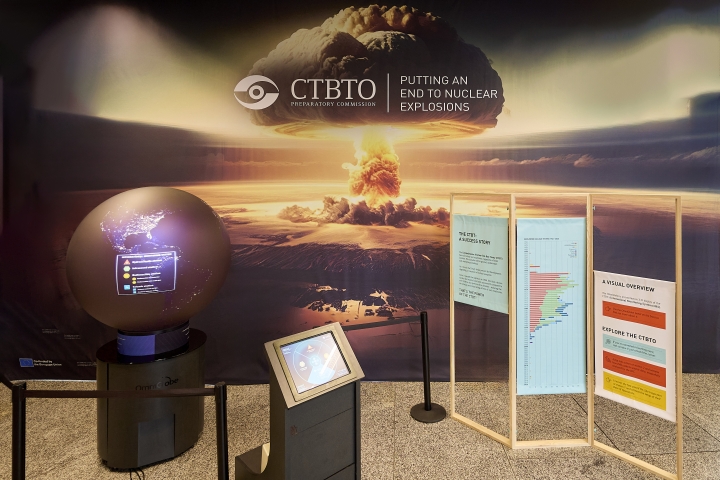
Station 9 featuring OmniGlobe, interactive data visualisation tool
